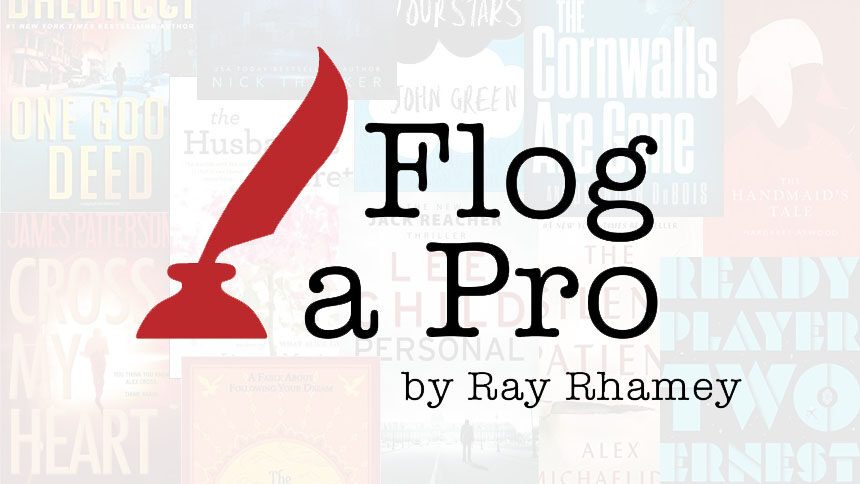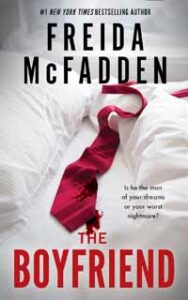Flog a Pro: Would You Turn the First Page of this Bestseller?
By Ray Rhamey | October 17, 2024 |

Trained by reading hundreds of submissions, editors and agents often make their read/not-read decision on the first page. In a customarily formatted book manuscript with chapters starting about 1/3 of the way down the page (double-spaced, 1-inch margins, 12-point type), there are 16 or 17 lines on the first page.
Here’s the question:
Would you pay good money to read the rest of the chapter? With 50 chapters in a book that costs $15, each chapter would be “worth” 30 cents.
So, before you read the excerpt, take 30 cents from your pocket or purse. When you’re done, decide what to do with those three dimes or the quarter and a nickel. It’s not much, but think of paying 30 cents for the rest of the chapter every time you sample a book’s first page. In a sense, time is money for a literary agent working her way through a raft of submissions, and she is spending that resource whenever she turns a page.
Please judge by storytelling quality, not by genre or content—some reject an opening page immediately because of genre, but that’s not a good-enough reason when the point is to analyze for storytelling strength.
How strong is the opening page of this novel—would it, all on its own, hook an agent if it was submitted by an unpublished writer?
I am desperately, painfully, completely, and stupidly in love.
Her name is Daisy. We met when we were four years old. I’ve been in love with the girl since age four—that’s how pathetic I am. I saw her at the playground feeding bits of her sandwich to the hungry squirrels, and all I could think was that I had never met any living creature as beautiful or as kind as Daisy Driscoll. And I was gone.
For a long time, I didn’t tell her how I felt. I couldn’t. It seemed impossible that this angel with golden hair and pale blue eyes and skin like the porcelain of our bathroom sink could ever feel a tenth of what I felt for her, so there was no point in trying.
But lately, that’s changed.
Lately, Daisy has been letting me walk her home from school. If I’m lucky, she lets me hold her hand, and she gives me that secret little smile on her cherry-red lips that makes my knees weak. I’m starting to think she might want me to kiss her.
But I’m scared. I’m scared that if I tried to kiss her, she would slap me across the face. I’m scared that if I told her how I really feel, she would look at me in sympathy and tell me she doesn’t feel the same way. I’m scared she might never let me walk her home again.
But that’s not what I’m most scared of.
What I am most scared of is that if I lean in to kiss Daisy, she will let me do it. I’m scared (snip)
 You can turn the page and read more here. Kindle users can request a sample sent to their devices, and I’ve found this to be a great way to evaluate a narrative that is borderline on the first page and see if it’s worth my coin.
You can turn the page and read more here. Kindle users can request a sample sent to their devices, and I’ve found this to be a great way to evaluate a narrative that is borderline on the first page and see if it’s worth my coin.
This novel was number one on the New York Times trade paperback fiction bestseller list for October 20, 2024. Was the prologue of The Boyfriend by Freida McFadden compelling?
My vote: Yes.
This book received 4.4 out of 5 stars on Amazon. I’m generally not a fan of prologues, and I’ve heard that many agents just skip them because they know the story starts with chapter one. But this one . . .
The narrative was oddly compelling for me; I was drawn in by the description of Daisy and the narrator’s feelings for her (why does it seem like just about all super-beautiful females in novels are blond, blue-eyed, and porcelain of skin?) With all of the adoration going on, it raises a story question for me when we get to his fear of what will happen if she lets him kiss her. Why? And what will happen next?
Just two lines later, we get this, the end of the prologue:
And I’m terrified that the moment I get her alone, I will wrap my fingers around her pretty, white neck and squeeze the life out of her.
Yeeks! Now I really want to turn the page. This is a prologue that works for me. What about you? Your thoughts?
[coffee]










Not even a little bit … but if I’d read those last two lines, then yes! I’ve avoided Frieda McFadden, having seen her called “Colleen Hoover for thrillers” but she must be doing something right; her books are WILDLY popular.
I had the same reaction.
I did too. Perhaps I’d change my mind if I had read the last two lines, but, based on the snippet, I was cringing. Cliche description, bad metaphor. Skin as white as a porcelain sink? Really? A sink???? Kind of clunky writing too. The last two lines might have hooked me, but I’m not positive.
I am absolutely with Lily, Leslie and Leslie on this one. Cliche in so many ways. The last two lines–the fear–that could be interesting. But let’s get real: 4-year olds don’t think that way. 14, yes, but not 4. And is that how old our protagonist is? Really we have no idea. Holding her hand, walking home from school? Is this 1950? Just can’t figure out where we are, bad opening in my opinion.
Of course, if we were reading in a bookstore or library, we’d have seen the cover, author’s name, and cover copy, so we’d have had some expectations already, and that might have shaped our reactions a little differently.
Yes, but the challenge here is how bestsellers’ first pages hold up when submitted the way the rest of us submit to agents–no cover, no blurb, just a statement from the writer.
Which begs the question: how do so many hyped best-sellers have openings that we here on Writer Unboxed (a fairly well read and written community) give a thumbs-down? Is the publishing world really just a marketing game, a brand-selling carousel?
I read “The Boyfriend” and “The Housemaid.” They are both compulsive reads. Did he do it? Did she do it? Did they do it together?” Is he a good guy or a serial killer? She’s acting strange, maybe it’s her? These questions pop in and out of your head while reading and, while you think you’ve got it figured out, there’s always a surprise or two up Frieda McFadden’s sleeve.
Definitely not. That opening gives me zero confidence in the author. “I am…” as a first line leaves a lot to be desired. “I am…” followed by four adverbs? Sheesh. There’s also the repetition. Perhaps that’s the voice-y aspect people like about McFadden, but the repetition of the name and four-years old feels more like a first draft to me. And, as you noted, she doesn’t skimp on the cliches: the blue eyes and porcelain skin and cherry-red lips that make him… wait for it: weak in the knees. It’s just too much (for me), but I can appreciate that others might find it compelling.
I typically don’t read thrillers but voted Yes. Some stories sweep you away rather than focus on abuse of adverbs.
In thrillers, the purpose of a prologue is to create a sense of menace. We start to be afraid, or at least uneasy. That’s the theory. Here, the intended effect is more on the uneasy end of the scale. This boy’s objectification of the girl is flat, mechanical and creepy.
There’s an argument to be made that the air of menace is necessary, that “uh-oh-watch-out” signals need to be sent to the reader. That’s probably right but at this point we’ve read it a thousand times, so the question I think is not whether to prologue or not, but whether the strategy in any particular opening is original enough to create the intended effect.
In this one my vote is…mmm, maybe, maybe not. It’s not setting up any surprises, ask me. There’s not much art to it. I tolerate it more than love it.
There’s a long tradition of good-guy-is-actually-bad thrillers (and vice versa). One of my favorites is Hitchcock’s film “Shadow of a Doubt” (1943). In that masterpiece, the menace is not forced down our throats with a prologue but builds gradually and achieves a high pitch without the guessing game that is the basic plot strategy of thrillers like McFadden’s.
There are many ways to thrill, I’m just finding this one opening a tad mechanical and a bit too easy. It’s “creepy” but obviously and deliberately so. That’s my take.
I read so few thrillers that if it were to begin, “It was a dark and stormy night …” , I’d turn the page.
But I always learn something from your comments. Thanks for your insight!
Maybe I’m being overly literal, but I don’t buy a four-year-old having that emotional reaction to the sight of another person. That’s not even kindergarten – that’s preschool age. That took me out of the rest of the narrative. Making the characters just a couple of years older might have brought me over, but I voted No.
Yuck.
I realize I’m supposed to look at this as if I were a literary agent, but if I were a literary agent, I would not represent someone who wrote this kind of thing, even if it meant giving up beaucoup bucks.
No, no, a thousand times no, as Betty Boop would sing. A child objectifying another child in order to fantasize about brutalizing her flew past creepy a few clichés ago.
This one was interesting. Usually, I have made up my mind after a couple of paragraphs, but this was written just well enough to *incline* me to at least turn the page. Sticking out among the cliches that bothered several of you was the sudden clinker of the skin “like the porcelain of our bathroom sink.” Yes, very white, but really? I wondered if the writer had done that on purpose. I decided that I would turn the page, making this the 114th time I have voted in the minority.
I didn’t believe the narrator…and after those extra two lines, definitely not.
I leaned no, on a technicality the lines that would have won me over are on page two. I’ve read five of her novels. One was a DNF but the other four were quite good from a twisty thriller perspective. Her wildly popular books are a little light character depth for me, though I quite enjoyed The Inmate and The Teacher because they indeed went deeper.
This opening, for the reason cited by others, did not grab me. If I knew this was a thriller going in I’d read more than a page knowing this is setup and the author should sprint the surpise in short order. The voice is not as compelling as some of her other works.
For an unkown author I would pass.
A definite no. Even with the last lines included, the set-up sounded tired and stale (an angel with golden hair, blue eyes, and porcelain skin). The narrator didn’t even rise to the level of creepy, more a paper tiger than the real thing. As Don Maass said, the approach wasn’t original to merit interest.
I was drawn in by the voice and the charming situation of (very) young love. I began to get a little put off toward the end of the page. Blonde hair, blue eyes, cherry lips, porcelain skin? It’s a stereotype but why? And his obsession with her was bothering me. I likely would have turned the page, but with a slight sense of trepidation.
And after reading those extra lines you quoted, I would have hastily put the book back on the shelf. Definitely not for me. Ugh.
I voted yes, even though I’m sure I wouldn’t read more, because I’m not a YA romance type of person. But as far as those go, the opening isn’t bad at all.
It’s interesting that, while the votes and comments here were overwhelmingly negative, if you look at the book on Goodreads, it has 88,899 ratings, average 4.09 stars. And her book, “The Housemaid,” which has a similar voice and tone, has a whopping 1,610,772 ratings, average 4.32 stars! I’m a huge fan of well crafted prose, but it seems like that might not be what’s driving many readers to turn the page. I wonder sometimes if many readers find cliches comfortingly familiar and are far less likely to turn up their noses, as most writers are. Maybe an agent and/or a publisher was prescient enough to recognize that and said “yes.” Just throwing that out there.
Good point, Denise. The 50th-in-a-series of James Patterson potboilers outsells the more original, probing book by an unknown author.
I’m starting to wonder that, too. There’s a reason they’re cliches. Some readers don’t want to work too hard.